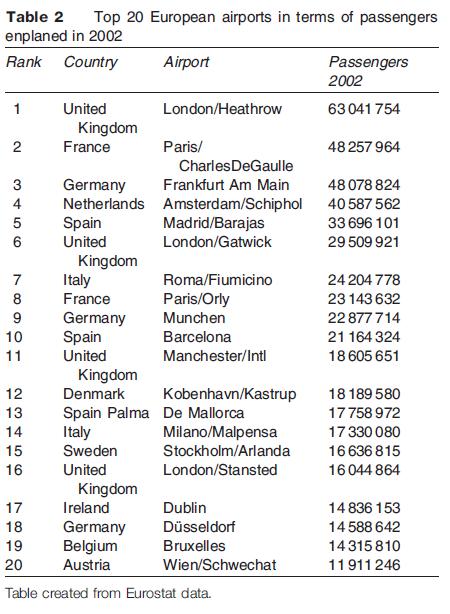Aviation
The study of air transport geography can be divided into three sections of inquiry: airlines/industry, airports, and aircraft. Air transport geographers are generally concerned with examining the role these different components have, either separately or in combination, in the geographic distribution of human activities across space.
The majority of air passenger and cargo traffic is concentrated in and between three regions: North America, Europe, and East Asia. Figure 1 shows the entire top 30 airports in terms of passenger enplanements that are located in these regions with North America having 18 and Europe and East Asia six each. The top 30 airports in terms of cargo handled, shown in Table 1, shows a similar geographic spread with 12 of the top 30 in North America, 11 in East Asia, six in Europe, and one, Dubai, in the Middle East.

Within North America the geography of air transport is focused primarily around flowing passengers through the many hubs operated by the numerous carriers in the market. These hubs serve two purposes: first to act as multidirectional hubs for connecting traffic and second to act as regional collection points for traffic from smaller centers. The primary flow directions are north–south flows along both the Atlantic and Pacific coast and east–west transcontinental flows.
European air traffic is heavily focused on a band running southeast from London and Amsterdam in the north through Paris and Frankfurt down to Milan and Rome in the south. The liberalization of the European markets has left two strong geographic footprints. The first is the emergence of four strong hubs at London Heathrow, Amsterdam, Frankfurt, and Paris De Gaulle, which in turn has led to a shift away from national net works, shown in Table 2. The second geographic impact of liberalization is the emergence of low cost carriers, led by the highly successful Ryanair, which in turn has led to the appearance of a strong network of secondary airports concentrating on providing accessibility for holiday makers in the northern parts of the continent to leisure destinations in the southern part.

The East Asian market is the fastest growing market in the world. Flows here are focused around three areas: the Southeast Asian hubs of Singapore, Kuala Lumpur, and Bangkok; China's gateways of Hong Kong and Shanghai; and the North Asian hubs of Tokyo and Seoul. Global flows into and out of the region are focused primarily around Singapore, Hong Kong, and Tokyo. It is predicted that this region will continue its enormous growth rates due to the expansion of Chinese markets both do mestically and internationally.
Globally, airlines around the world serve 14 000 city pairs with over 75 000 flights daily. Estimates are that 40% of the value of all goods traded are transported by aircraft and the industry employs over 4 million people around the world and generates over $400 billion in economic output.